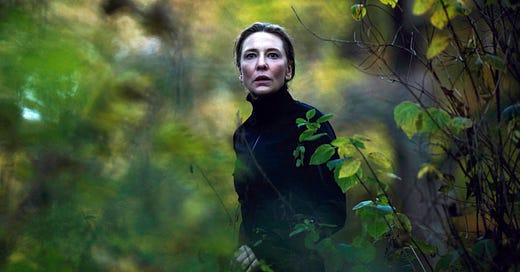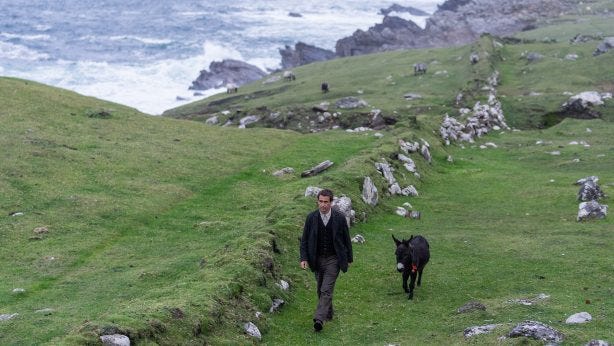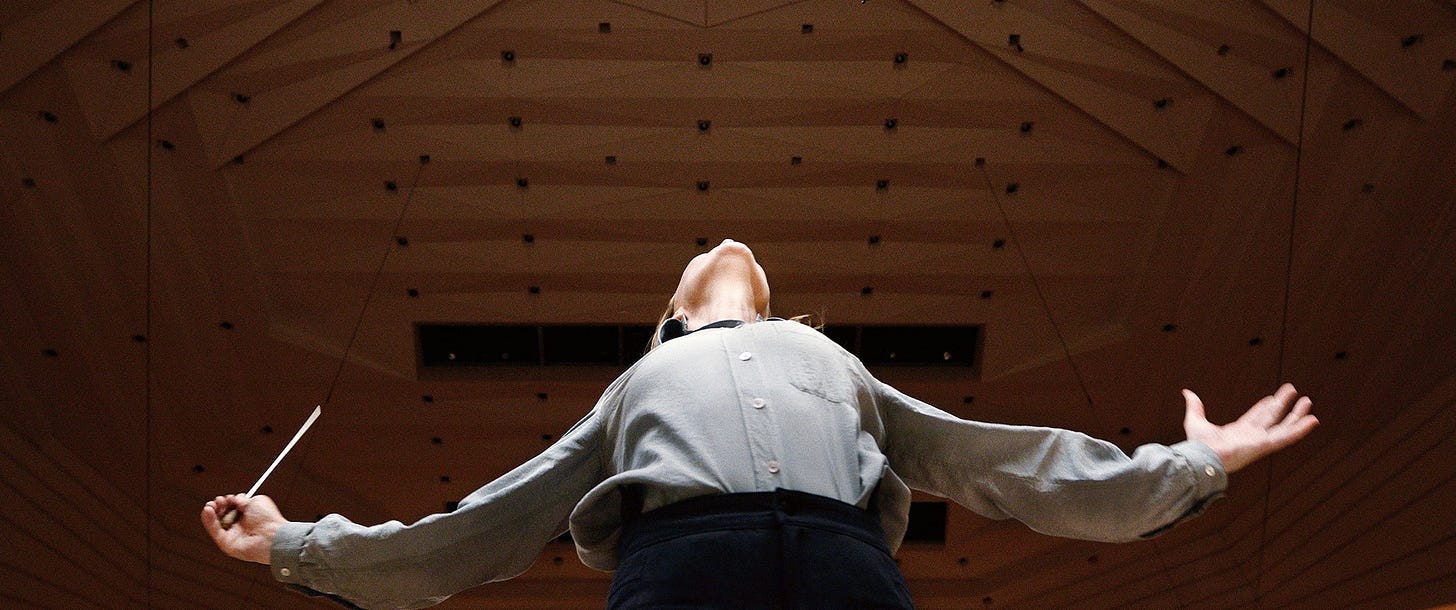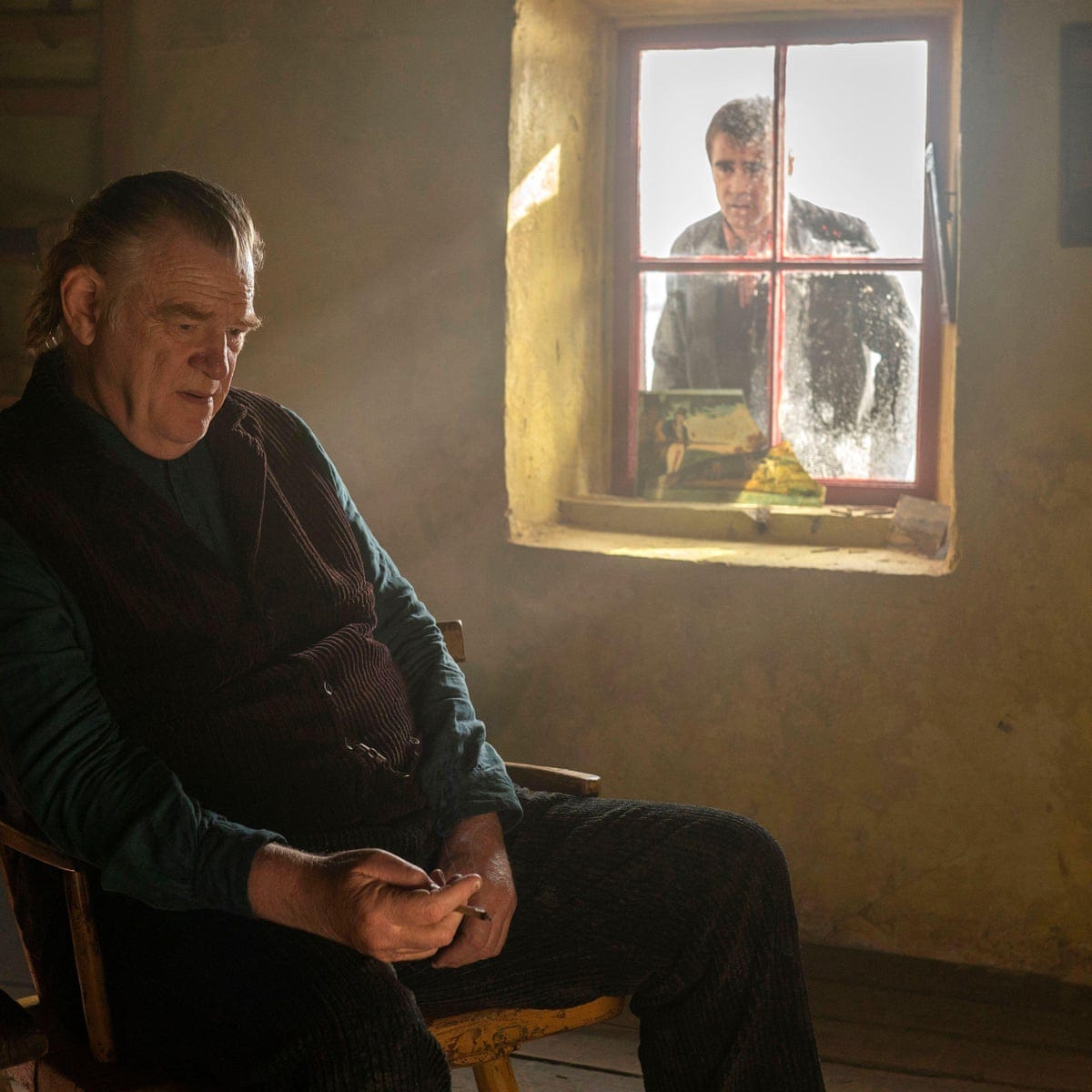Separating Art from the Artist: On Tár and The Banshees of Inisherin
More thoughts on two of the films I thought most about this year.
This post contains spoilers for the films mentioned.
I’ve already posted about my favorite films of the year but I want to expand a bit on the two that have made me think the most this year.
While watching Tár I was sometimes confused—at least one scene seemed to be out of chronological order for a few minutes, until I was oriented—and even frustrated until all the pieces came together to reveal a brilliant piece of filmmaking. But I was always mesmerized. I couldn’t take my eyes off the performance of Cate Blanchett. I know that she is an infallible goddess to many people but for me she is hit or miss (I predict that her performance in Carol will eventually be held up as high camp, along the lines of Faye Dunaway’s portrayal of Joan Crawford in Mommie Dearest). In Tár it’s all hit; this is the performance of the year.
The other element of the film that I found to be overwhelming in all the best ways is the sound design. It’s a movie about a conductor so of course there are some incredible moments of classical music being performed. But its the smaller moments—a metronome ticking ominously, a woman screaming in the distance—that remind you of the brilliant sound design (the screams, for example, came from the speakers behind us in the cinema where we saw it, while the other sounds of the scene came from the sides, so that there was a brief moment where I thought the screams were actually coming from outside and not part of the film; a brilliant move because I was mirroring the confusion of the character on screen who couldn’t figure out from which direction the sound is coming).
There are so many elements in Tár that make for great discussions; I encourage you to see it with people with whom you love to have complex conversations. We saw it with two of our closest friends who have similar film aesthetics. Upon leaving my husband and I both loved it, one friend liked it, and another did not like it. After we had talked about it for two hours we all four decided that it was a brilliant film and that we loved it. It’s that kind of movie—the more you think about it, the better it becomes. There are so many layers—the way women get held to different standards, especially when they are in seats of power; the difficulties of separating art from the artist who created it; fidelity; parenthood; power; gender (in one particularly electrifying scene Tár threatens her daughter’s bully by telling her “I’m Petra’s father” despite the fact that Tár is always referred to as a woman throughout the film); gaslighting; the way the internet reduces everything to absolutes; and so much more. But the thing that struck me the most about the film is one of its most subtle themes: class.
Zadie Smith recently published a think-piece/review about Tár in The New York Review of Books. It is a remarkable piece of writing. But I was struck by two things in particular: the way Smith makes fun of the main character of Tár for being a Cultural Luminary without realizing that she is one herself and, most importantly, the way Smith fails to mention that one of the major themes of the film is class (this same thing struck me about her beautifully written book of essays, Intimations, in which her own upper class position seems to occasionally cloud her awareness of class dynamic). In a scene late in the film we are subtly told that Tár was raised working class, and most likely lower working class. She returns to her small, cramped childhood home and encounters a brother who is obviously still working class and exhausted with the highfalutin stylings of his sister. A glimpse at a high school certificate shows us that the character we’ve been with for two hours—the posh-accented Lydia Tár of the multimillion dollar home in Berlin—is actually Linda Tar (note the lack of an accent over the a) from Staten Island. This blink-and-you-miss-it detail suggests so much. To me it signaled that she has been “passing”—she’s the product of a working class environment within the ultra-monied world of classical music. It said to me that she had to do twice the work of anybody else not only because she was a woman but also because she was not raised with money. It tells us that she changed her name to sound and appear less working class (one scene in the film shows us the way she strives to dress more like a male conductor to be taken more seriously). But it also made me wonder this: if she changed her name and doesn’t talk about her working class roots (the opening is a deep dive into her biography, and it’s important to note that her first biographical note is that she graduated from Harvard, as if she has erased everything from her life before that) then has she perhaps also lied to move up the ladder in the wealthy world of classical music? As a person who was raised working class and who lived a significant chunk of my life in a trailer I often feel like an oddball in the literary world, which is more monied than you can ever imagine. Every working class-raised person I know in literature suffers from imposter syndrome, and also suffers from not being taken seriously enough by the literary elite. I can count on one hand the number of “big” writers in the literary world who were not raised with money. There are literary prizes and grants that won’t even think of giving awards to anyone who went to a state university and turn their noses up at anyone who is from a state that they consider part of Trump Country. This was definitely important to the writer/director, Todd Field, who has said in an interview that the class background is incredibly important to her character. He did extensive thinking about where she grew up—thinking that is suggested more than shown in the film itself. “I can tell you its proximity to Fresh Kills, the largest landfill on Earth where her father worked,” Field says. “And I could talk about the smell of the garbage coming through those windows.”
My point here is to say that one of the most interesting aspects of Tár, to me, is what is not onscreen. What has happened before the film starts, what is ambiguous. To me that’s one of the best things about it because it’s also what makes me, as a viewer, think more about it. I think Tár is the film of the year. Every performance in it is superior and it is written and directed by one of my favorite filmmakers, Todd Field. His script for the film is a master class in writing and can be read here.
While I went to see Tár mostly because I am such a huge fan of Field, who also made In the Bedroom (one of my all-time favorite movies) and Little Children, I approached The Banshees of Inisherin, written and directed by Martin McDonagh, with hesitation. On my first trip to Ireland I was at a dinner party populated by some of the country’s best musicians and writers and I was asked about my favorite pieces of Irish literature. I talked about Eavan Boland, W.B. Yeats, Seamus Heaney, Edna O’Brien, James Joyce, Bernard MacLaverty, and many others that had the whole table nodding their heads. But I also mentioned that I had recently seen The Cripple of Inishmaan on Broadway and liked it. The table went quiet until one older man piped up and diplomatically told me that I ought to be careful when consuming the work of Martin McDonagh. Another was more empathic. “McDonagh is a phony,” he said.
I had not known that McDonagh was born and raised in England, and since so much of his work is about Ireland, I was surprised to learn this. His parents are from West Ireland, but still, he was raised with an English sensibility. In fact, his parents moved back to Ireland when he was in his early twenties and he chose to remain in London. Worse than this, many Irish people felt that he had made a fortune by using stereotypes of Irish people. McDonagh argues that he likes to focus on “eccentric people” in his portrayals of the Irish, a defense that many people have used when portraying Appalachian stereotypes. “The fetishization of the West and Irish culture, more generally within the diaspora, is highly common. Children of Irish emigrants, or even those more distantly Irish, are often accused of being Plastic Paddies due to their attachment to inauthentic Irish tropes,” cultural critic Anne Marie Kingsland has written.
Many of the Irish people I know tell me that McDonagh is thought of as similar to the way Appalachians think of J.D. Vance: Vance is not really from Appalachia (he is two entire generations removed from the region; his grandparent left when they were teenagers) but has made a fortune trumpeting himself as a representative of the region; Vance uses stereotypes that most people already possess of Appalachia to tap into their desire to have these suspicions solidified. The same could be argued about the way McDonagh portrays the Irish although I do not think he is considered as dangerous or problematic since he is not a politician like Vance. And I should point out here that not every Irish person I know feels that way about McDonagh, but the vast majority do.
When I saw McDonagh’s meditation on rural America, Three Billboards Outside Ebbings, Missouri, in 2017, I understood even better what my Irish friends had been telling me. That film is full of tired rural stereotypes that have been used to malign non-urban Americans for over a century now. The characters are mostly portrayed as violent, racist, alcoholic, dumb. I am not saying that some rural Americans are not some or all of these things. Of course they are, since they are human beings and human beings sometimes fall into many of these categories. But the film suggests that all rural people fit neatly into one or multiple of these traits. It’s the age-old problem of stereotypes about the way of life: rural America as a monolith. Most bothersome to me was the fact that McDonagh just does not understand rural America as well as he thinks he does. I wonder if the same is true for him and Ireland? In Three Billboards he presents a troublingly simplified idea that sells movie tickets and books: that rural Americans are simple people who are either inherently pure or inherently bad. The truth is that rural American people are complex. They rarely get shown that way on film or in books because most people don’t want to think of them that way. Most want a version that doesn’t require much thought outside what they’ve been taught their entire lives about us.
Still, I wanted to see The Banshees of Inisherin because I love Inis Mór, the Aran Island in Galway Bay where most of the film was shot, because I love the four main actors in the film (all Irish, by the way), and because despite my issues with McDonagh, his art is always interesting and beautiful to look at. Banshees certainly is that. The vistas of the fictional island of Inisherin (literarlly, the Island of Ireland—like a big flashing neon sign to say “This is the definitive movie about Ireland!”)—are breathtaking, if sometimes stereotypical: in the opening our beaming main character walks along the pier with a lovely rainbow shining on the water behind him, as if presenting the most idyllic representation of Ireland possible. To be fair, the climate of Ireland does lead to an enormous amount of rainbows, but you get my point. There are scenes set at some of the most powerful and picturesque locations on the island: two characters sit on the edge of the high cliffs at Dun Aengus, an ancient fort, another character’s house is situated on what is in reality the main beach on Inis Mór, many scenes are set on the stark pier that is punctuated by its looming Celtic cross, like an exclamation point at the end of the title to emphasize just how Irish this whole enterprise truly is.
The stereotypical characters abound: the many Irish who are musical prodigies, the town’s “simpleton” (I’m using this word as a mode of literary analysis, not as a commentary on mental status); a witch, puffing on a pipe and costumed almost exactly like the witch in Snow White, wanders the island, always popping up to spout a prophecy or to be creepy; the bookish sister who escapes because she is just too intelligent for rural life (the escape fantasy is a constant stereotype of Appalachian media, as well); violent, drunken men, etc.
I was troubled by a scene in which the main character, Pádraic, hears gunfire coming from the civil war being waged on the mainland and says aloud: “Good luck to you, whatever you’re fighting about.” Later we’ll realize that this may have something to do with one of the main themes of the film (violence is senseless) but it is also troubling when we consider that an Englishman is writing this scene in which a character meant to represent Ireland is being dismissive of people fighting for their independence from the English. Pádraic is the Gaelic form of Patrick, after all; Patrick is the patron saint of Ireland—it isn’t hard to figure out that Padraic is meant to represent traditional Irish people. If this film was set in Appalachia instead of Ireland this scene would be equivalent to an Appalachian not understanding the significance of coal miners fighting for their rights in the 1920s. In fact, Pádraic doesn’t seem to not understand the civil war so much as he seems to be negating the fight for independence.
Many people leave this film scratching their heads as to what it is all about. I think it’s mostly up to your own interpretation. The main plot is that Colm (played by Brendan Gleeson) suddenly decides he doesn’t want to be friends with Pádraic (played by Colin Farrell) anymore and is so insistent about this that he declares he will cut his fingers off if Pádraic talks to him again. It’s a parable, but for what? Farrell has said in an interview that to him the film is about “the disintegration of joy” and that sums it up pretty well. In the opening Pádraic is content with his rural life of drinking with friends and being with his animals and by the end he has lost nearly everything he loves, even his ability to find happiness in simple things. But I think the symbolism is too heavy throughout to not also think that the film is a commentary on the history of violence in Ireland and what defines the country. The title certainly seems to suggest as much. To me, the sudden decision to end a friendship is a way of thinking about the roots of hatred between Protestants and Catholics—the films seems to be asking if one of them simply decided to hate the other one day?—and the extreme measures taken (in this case, a talented fiddler cutting off his fingers to make his point) is a commentary on the way violence doesn’t solve anything. Those caught in the crossfire of the civil war, and, later on, The Troubles—here personified by a miniature donkey and the aforementioned “simpleton” who are actually the hearts of the film and both killed—suffer the consequences. The villainous policeman might be McDonagh’s way of recognizing that the English played an essential part in keeping the people divided and violent but it’s not enough, in my opinion, and I feel like that’s because McDonagh is being blasé on this matter. The bookish sister represents all the Irish who had to flee because of the violence and its resultant lack of opportunities.
I loved the performances. The cinematography. The perfect score by Carter Burwell (not to mention that opening song, “Polegnala E Todora (Theodora Is Dozing)”, which is, strangely enough, sung by The Ensemble of the Bulgarian Republic), who made the wise choice to not use Irish folk music. Most of all I loved the animals. The miniature donkey, Jenny. The good dog. The horse, grieving for the donkey. The goats, melancholy on the hill in the gloaming. I loved the way McDonagh writes about and shows animals. To me, the most beautiful exchange in the film is when the priest asks Colm if God “gives a damn” about animals and Colm answers, “I fear he doesn’t. And I fear that’s where it’s all gone wrong.”
All of this to say that I found this to be a beautiful, compelling film for adults, despite the way I feel about McDonagh. I think, more than anything, it is important to consider the problems that many Irish people have with McDonagh and the way he has appropriated Irish stories in sometimes troubling ways.
Which brings us full circle if we think back to the way that one of the main themes of Tár is about having the ability to separate the piece of art from the artist. In Tár, a widely discussed indiscretion on Lydia Tár’s part makes people begin to question if she is a monster and if this reshapes her art, and their consumption of it. The ending of the film certainly shows us an artist whose devotion to art has not changed because of her problematic nature. Her downfall from one of the Cultural Luminaries to a humiliating stint conducting for an audience full of Cosplayers hasn’t reduced her desire to be a great artist. It is in that moment—the very end of the film—where I thought the most about how she had likely been held back due to her class upbringing and lack of opportunities. This didn’t make me forgive her for her transgressions but it did complexity her further as a character. It revealed a vulnerability in her that she did not reveal to people. To me, that moment is saying that bad people can still possess the potential of and appreciation for beauty. And it also makes me question the definitions of what makes her good or bad. Perhaps she is simply a human being who messed up…or maybe it much worse than that. Has she gotten so far away from that little girl who so admired Leonard Bernstein’s desire to bring the power of classical music to the masses that she has lost the very humanity she recognized in the art to begin with?
I sometimes find it difficult to think about a film, a book, or a piece of music without thinking of problematic aspects of the artist, especially when the privilege of the artist is shaping the piece of art, but ultimately I want to judge the piece of art itself, and not the artist who made it. I would not pay money to see a standup show by Dave Chapelle because I am so offended by his transphobic and elitist rants (telling people they don’t like Elon Musk just because they’re “poor”, for example). But I would not be in favor of any law that prohibited others from seeing him. I hesitate to add to J.K. Rowlings coffers because of her TERF evangelizing, but that does not negate the incredible stories she created for Harry Potter and I certainly would not want her books to be banned because of her opinions and actions.
In film this is more complicated. After all, if I never again watch The Purple Rose of Cairo because of my feelings about Woody Allen or Rosemary’s Baby because of my opposition to Roman Polanski, do I not also erase the phenomenal performances in both films by Mia Farrow, who is just as much a factor in those pieces of art as the directors? Am I to boycott a film like The Banshees of Inisherin because I am opposed to the actions of its writer and director and then not be able to witness, and celebrate, the incredible peformances of Irish actors such as Farrell, Gleeson, Kerry Condon, and Barry Keoghan or to revisit landscapes I love? Furthermore, I have to take into consideration that a person whose actions I find problematic is still capable of creating a great work of art such as The Banshees of Inisherin, or, in the matter of a fictional character, the ability to bring forth the full emotion of a piece of music the way Lydia Tár is capable of doing. These are complicated questions. They are also the kinds of questions that we need art to help us answer.








Thanks for this. I’ve seen both. And thought a lot about both, and liked Zadie Smith’s article. She didn’t persuade me to like Tar, but I liked her insights on generational change. I like her ability to value her own approach and views, and at the same time to be open to and curious about the insights of the next generation (especially around art and politics). Plus she is funny. Re The Banshees, I think the background is the Civil War (not The Troubles) since it is set in 1923. And so the ending of friendships and the self mutilation and self-deforming all make sense. Yea, the stereotypes are all, well, of course, over drawn and predictable, it it is more allegory than anything else. And yet, as you note, superb acting and lines delivered with perfect timing. Thanks for writing! PS I did not know the Irish view of McDonough.
I read this awhile back and found it thought-provoking, as I sometimes avoid the art of people whose actions I find objectionable. Then I just found out that the King County (WA) Library System has chosen "Monsters, a Fan's Dilemma" by Claire Dederer as its Community Read selection. https://www.npr.org/2023/05/10/1174293359/monsters-a-fans-dilemma-review-claire-dederer